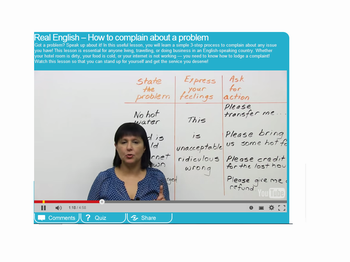- Recursos multimídia;
- imagens veiculadas na internet;
- atividades online;
- atividades xerocopiadas;
- diálogos;
- discussões;
- vídeo;
- atividades de produção oral;
- atividades de compreensão escrita;
- atividades de compreensão auditiva.
COMPLAINING

Imagem disponível em: https://www.google.com.br/search?hl=pt-PT&site=imghp&tbm=isch&source=hp&biw=1024&bih=600&q=complaining&oq=complaining&gs_l=img.1.0.0j0i24l9.119.7154.0.9585.30.20.2.0.0.1.
612.2391.2-2j4j0j1.7.0....0...1ac.1.51.img..22.8.2085._tfcj2qB10k&gws_rd=ssl#facrc=_&imgdii=_&imgrc=AL4D4jHEOyoIsM%253A%3BDZtUI5oj3H8e5M%3Bhttp
%253A%252F%252Fi299.photobucket.com%252Falbums%252Fmm296%252FSearch-Discover%252FAmerican%252520Dream%252FStop-Complaining.jpg%3Bhttp%253A%252F%252Fs299.photobucket.com%252Fuser%252FSearch-Discover%252Fmedia%252FAmerican%252520Dream%252FStop-Complaining.jpg.html%3B650%3B629 (Acesso em: 14.08.2014)
MÓDULO 1
Atividade 1
Projete o texto seguinte para os alunos, como atividade introdutória do tema da aula. Eles deverão realizar a leitura, revezando os turnos de fala. Corrija a pronúncia das palavras e tire as dúvidas em relação ao vocabulário desconhecido.
Complaining - Talking about Complaints
What are complaints?
Complaints are expressions of "displeasure or annoyance" in response to an action that is seen by the speaker as unfavorable. Suppose you want to complain about the pizza you have just ordered because it's too salty, what are the expressions needed to express and respond to complaints?
Complaining:
Here are expressions you can use when complaining:
- I have a complaint to make. ...
- Sorry to bother you but...
- I'm sorry to say this but...
- I'm afraid I've got a complaint about...
- I'm afraid there is a slight problem with...
- Excuse me but there is a problem about...
- I want to complain about...
- I'm angry about...
Examples:
| I have a complaint to make. |
Your pizza is just too salty.
|
|
I'm sorry to say this but
|
your food is inedible.
|
1. I'm afraid I've got a complaint about your child.He's too noisy .
2. I'm afraid there is a slight problem with the service in this hotel.
3.Excuse me but you are standing on my foot.
4. I want to complain about the noise you are making.
5. I'm angry about the way you treat me.
|
Responding to complaints
Positive response to complaints:
- I'm so sorry, but this will never occur / happen again.
- I'm sorry, we promise never to do the same mistake again.
- I'm really sorry; we'll do our utmost/best not to do the same mistake again.
Negative response to complaints:
- Sorry there is nothing we can do about it.
- I'm afraid, there isn't much we can do about it.
- We are sorry but the food is just alright.
Things to remember about complaints:
When expressing a complaint in English, it helps to be polite. Although "I'm angry about your pizza. It's too salty" is one possible way of expressing a complaint, it is considered too rude and you'd better use more polite expressions if you want to get what you want!
Disponível em: http://www.myenglishpages.com/site_php_files/communication-lesson-complaininig.php#.U-7XGuNdUeg (Acesso em: 14.08.2014)
Atividade 2

Imagem disponivel em: https://www.google.com.br/search?hl=pt-PT&site=imghp&tbm=isch&source=hp&biw=1024&bih=643&q=eating+at+a+restaurant&oq=eating+at+a+restaurant&gs_l=img.3..0i19l4.1144.4108.0.
4805.22.8.0.9.9.0.294.827.2-3.3.0....0...1ac.1.51.img..10.12.885.W2y2HitPAl0&gws_rd=ssl#facrc=_&imgdii=_&imgrc=DsREkqTUTq-hLM%253A%3B8hrZ9XaSIFR8KM%3Bhttp%253A%252F%252Fcliparts4you.net%252Fwp-content%252Fuploads%252F2014%252F07%252Fclipart-
restaurantold-woman-eating-in-a-restaurant-clipart---royalty-free-clipart-image-3ui13rvk.jpg%3Bhttp%253A%252F%252Fcliparts4you.net%252Fold-
woman-eating-in-a-restaurant-clipart-royalty-free-clipart-image.html%3B350%3B336 (Acesso em: 16.08.2014)
Distribua aos alunos o seguinte texto em que quatro clientes (Julie, Andrew, Sally & Peter) têm problemas ao comerem em um restaurante. Durante a leitura, há algumas expressões marcadas em negrito. Peça para que os alunos infiram os seus significados, a partir do contexto. Em seguida, peça para que respondam ao teste, conferindo as suas inferências quanto ao significado das expressões negritadas.
Problems in a restaurant
Waiter:'Good evening Madam, how can I help you?'
Julie:'Good evening. We have a reservation for 9 pm in the name of Smith.'
Waiter:'A table for four, isn't it? I'm afraid that the table isn't available yet. If you'd like to wait at the bar, we'll call you over when it's ready.'
30 minutes later
Julie:'Excuse me, we've been waiting for 30 minutes for our table. Will it be much longer?'
Waiter:'Sorry about the delay, we're very busy tonight. I'll just go and check.'
2 minutes later
Waiter:'Your table is ready now. If you would like to come with me, I will show you to your table.'
5 minutes later when the customers are seated at their table
Andrew:'My god, the people at the table next to ours are shouting. I can't hear myself think!'
Julie:'They are talking very loud. I'll take care of it. I will speak to the waiter and see if we can move tables. Excuse me, would it be possible to change tables?'
Waiter:'Is there a problem with the table madam?'
Julie:'Not with the table, but the table next to us are speaking very loudly.'
Waiter:'I will ask them to quieten down, so you can enjoy your meal without the shouting.'
20 minutes later, the waiter is serving them their first course/starter
Andrew:'Excuse me, I didn't order the smoked salmon.'
Waiter:'I have smoked salmon written down here.'
Andrew:'I am afraid you are mistaken. I asked for the tomato and basil soup for my starter.'
Waiter:'I'm terribly sorry sir. I'll replace it straight away.'
Peter:'Excuse me, would it be possible to change my starter?'
Waiter:'Is there anything wrong with your prawn salad sir?'
Peter:'No, there isn't. I wasn't expecting the prawn salad to look like this.'
Waiter:'No problem sir. What would you like instead?'
Peter:'Could I have a caesar salad if it's no trouble?'
Waiter:'I am afraid we are sold out of the caesar salad. We don't have any more tonight. May I recommend the tomato and basil soup. It's very good.'
Peter:'I'll have that then. Thank you.'
Waiter:'I'll bring the soups now.'
QUIZ
1. A polite phrase which a customer uses when they want to change something, is ................................
2. A different way to say 'I didn't ask for' in a restaurant, is ............................................
3. When a restaurant has 'no more' of a dish or drink, it is ...................................
4. A phrase which means 'how much more time do we have to wait?', is ...................................
5. A phrasal verb which means to 'speak more quietly', is .....................................
6. A phrase a waiter says when they need to speak to somebody else to answer a customer's question, is ..........................
7. A phrase that means that 'I will resolve a problem', is ...................................................
8. A polite way to say 'you are wrong', is ......................................................
9. A phrase that is used by a customer to say what time they arranged earlier to start to eat in the restaurant, is ...........
10. A different way to say 'if it's not a problem', is ..............................
Fonte: http://www.blairenglish.com/exercises/social/exercises/complain_problems_restaurant_1/complain_problems_restaurant_1.html
(acesso em 16.08.2014)

Atividade 3
Distribua a seguinte atividade aos alunos e peça para que coloquem os diálogos em ordem. Explique a situação em que os diálogos ocorrem, facilitando o entendimento dos alunos. Após a correção, os alunos, em duplas, deverão praticar os quatro diálogos.
You are having dinner at Dawn’s Delicious Bistro.
The food is horrible and the service is terrible.
Put the conversations in the correct order.
A)
____Waiter: I’m very sorry, I’ll change it immediately.
____You: Excuse me, waiter!
____You: My pizza is burnt and my chips are cold.
____Waiter: Yes Sir
B)
____ Waiter: I’ll bring a clean one.
____You: My spoon is dirty.
____ Waiter: Yes Madam
C)
____ you: excuse me waiter.
____ you: Yes, I ordered chips not salad.
____ waiter: I’m sorry Sir, I’ll bring your chips.
____ waiter: Yes, is there a problem?
D)
____ waiter: Yes madam
____ you: Excuse me waiter!
____ you: I ordered 30 minutes ago
____ waiter: I’m sorry, I’ll bring your food now.
Practice the conversations with a friend
Adaptado do site: http://busyteacher.org/2817-complain-in-a-restaurant.html (Acesso em: 14.08.2014)
MÓDULO 2
Atividade 4
Reproduza para os alunos o vídeo: How to complain about a problem, disponível em: http://www.engvid.com/real-english-how-to-complain-about-a-problem/ (Acesso em: 14.08.2014) e peça aos alunos para que anotem, para futuras consultas, as formas de se fazer reclamações, quais sejam:
a) state the problem;
b)express your feelings;
c) ask for action (state what you want).
No vídeo, a apresentadora narra uma situação em que teve que fazer uma reclamação pela compra de um produto danificado. Faça perguntas aos alunos, observando se eles conseguiram entender tal situação, como, por exemplo:
a) What happened to the speaker the other day? She bought a rost chichen whose leg was eaten by someone
b) How did she feel? She was shocked.
c) What did she do after she noticed that the chicken she has just bought had part of the leg eaten by someone? She went back to the supermarket and complained.
d) What did she ask for? She asked to get a replacement chicken and to get her money back.
Pause o vídeo para facilitar o entendimento dos alunos, possibilitando que respondam às perguntas acima elencadas. Reproduza o vídeo quantas vezes forem necessárias.

Imagem ilustrativa do referido vídeo
Atividade 5
A atividade a seguir consiste na leitura e representação de dois diálogos em que as pessoas reclamam por serviços não/mal prestados. Divida a turma em duplas e distribua um dos diálogos para cada dupla. Disponibilize um tempo de, aproximadamente, 10 minutos para que os alunos possam praticar a leitura do diálogo e tirar as dúvidas quanto ao vocabulário e pronúncia correta das palavras. Peça para que dois alunos leiam os diálogos em voz alta, para que você possa corrigir a pronúncia das palavras. Cada dupla deverá trocar os papeis, de forma que possam representar tanto o papel de quem reclama pelo serviço quanto o de quem tenta resolver o problema narrado.
| Dialog 1 – The missing parts . . . |
| A: Hello Mr. Chen, may I help you? |
| B: Yes, I ordered spare parts for my generator, but you sent the wrong parts. |
| A; Oh no! Can you tell me exactly what parts you ordered and what you got? |
| B: Yes, I ordered two of part number B235C, but I got two B235Ds instead! They won’t fit my generator. |
| A: I’m very sorry, let me check and see if we have the correct parts here right now and if we do, I can have someone deliver them this afternoon. Would that be okay? |
| B: Yes, please – the sooner I have the parts the better. |
| Later . . . . |
| A: Hello Mr. Chen, did you get the correct parts I sent over ? Are they exactly what you needed? |
| B: Yes, they just arrived. Thank you. |
| A: My pleasure Mr. Chen, again, sorry for the inconvenience. |
| |
| Dialog 2 – Shoddy service . . . |
| A: Hello, Anderson Pool Service, may I help you? |
| B: Yes this Dolly McBride, someone was supposed to clean my swimming pool today. No one came. |
| A: I’m sorry Ms. McBride, let me check the schedule and see what went wrong. Can I send someone over first thing tomorrow morning? |
| B: Yes, that would be okay. |
| Tomorrow . . . |
| A: Hello Ms. McBride? |
| B: Yes? |
| A: Did the pool cleaner get over there okay this morning? |
| B: Yes, everything is fine now. Thank you. |
| A: Thank you, Ms. McBride – and again – my apologies for the mix-up* yesterday. |
Disponível em: http://www.businessenglishebook.com/business-english-lessons-activities/business-english-complaints-lesson/ (Acesso em: 16.08.2014)
Atividade 6
Projete as seguintes imagens e textos para que os alunos, em duplas, possam fazer reclamações e respondê-las, utilizando-se das informações contidas no texto. Cada dupla deverá ficar responsável por uma imagem e um texto. Observe a distribuição das imagens, de modo que todas possam ser utilizadas pelas duplas. Circule pela sala, ajudando-os a elaborarem seus diálogos. Sugira que tenham como modelo os diálogos apresentados na atividade anterior. Disponibilize de 20 a 30 minutos para a realização do diálogo. Ao final, cada dupla deverá apresentar seu diálogo para o restante do grupo.
.
|  Name of Caller with Problem:
Sumida Jobes Calling to: Panasonic Problem: Ordered 20 DVD Recorders, got only 10. |
 Name of Caller with Problem:
Richard Canalez Calling to: Fire Stoppers, Inc. Problem: Bought a fire extinguisher, but it doesn’t work. |
|  Name of Caller with Problem:
Wendy Morales Calling to: Windy City Toyota Problem: Had her car painted last week at Toyota, but the paint is already starting to come off . |
 Name of Caller with Problem:
Bob White Calling to: Dog Sitters 4U Problem: Scheduled dog sitter for 2 p.m. today – no one came. Need a dog sitter right now! |
Disponível em: http://www.businessenglishebook.com/business-english-lessons-activities/business-english-complaints-lesson/business-english-complaints-activity/ (Acesso em: 16.08.2014)











